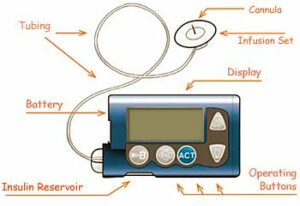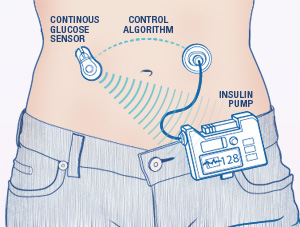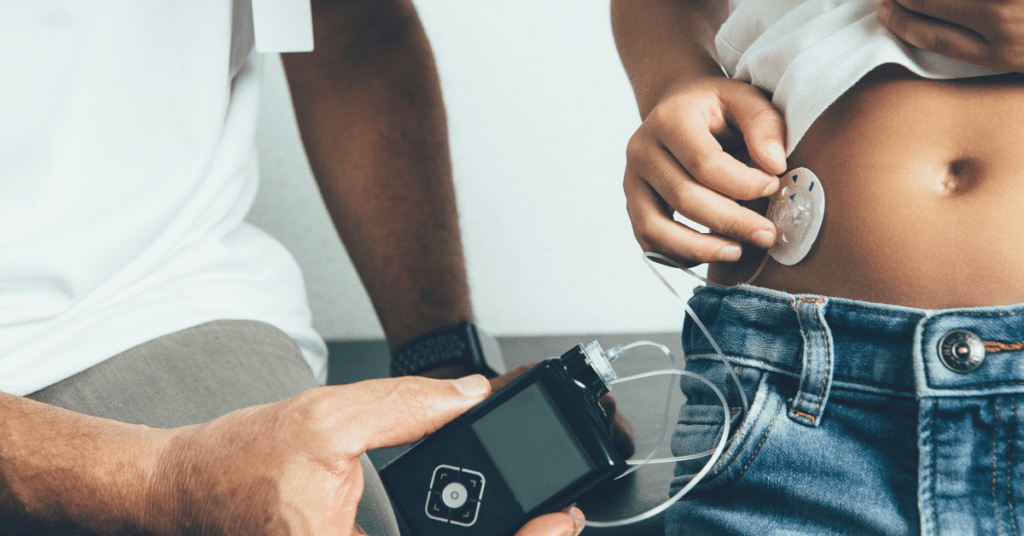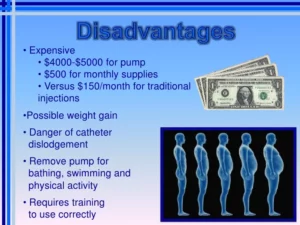Contents
Insulin Pump

The insulin pump is a device that delivers insulin continuously to type 1 and type 2 diabetes patients. This pump is believed to be the best treatment for diabetes, and it has been approved by FDA since 1997. It can be worn on the outside of your body or on your belt, and it’s often used along with other diabetes supplies. This device is powered by batteries, and it can store up to 3 days of insulin.
Who Is It For?
People who have type 1 or type 2 diabetes therapy for insulin pumps. They are useful in managing blood sugars levels to prevent further complications from developing. The use of the device may also improve control over glucose concentrations in diabetics suffering from poor circulation leading to reduced sensation in their feet.
How Does It Work?
Insulin Pumps deliver small amounts of rapid-acting insulin into your body throughout the day. Through a catheter that is inserted under your skin within the fatty tissue around your abdomen. This may be programmed based on your blood glucose level and the carbohydrates you consume. The insulin pump is convenient to wear and easy to operate. But it does require a lot of maintenance. You’ll have to change the catheter or infusion site every 3 days. Moreover, the device has an alarm system to remind you when it’s time for a new infusion set or cartridge. And these alarms can be scheduled by yourself conveniently through your personal computer.
Insulin Pump Parts
The insulin pump has several parts. These are-

Reservoir
This holds the insulin K 2 EDTA which is pumped around the body through a narrow tube called a cannula under the skin in fatty tissue around your belly (abdomen). The reservoir has an overfill protection system that will stop insulin delivery if it gets too full and also a plunger at the top to enable you to draw air into the reservoir.
Pump
This is a small computer that controls how much insulin is pumped out of the reservoir and when through the cannula under your skin. The pump can be programmed by you according to your requirements such as carbohydrates consumed, physical activities, blood glucose levels, and many other factors. Your healthcare professional (HCP) will set up this program for you based on your blood sugar records so that you don’t have large swings in blood sugars between meals or during sleep at night. You can alter these programs yourself using information from your meter readings or simply by altering the amounts of carbohydrates eaten.
Sensor
This is a small plastic device that detects when your blood sugar levels are high or low. It’s inserted under the skin usually on the abdomen, buttocks, arms, or legs with an adhesive pad to hold it in place. The sensor sends messages wirelessly every 5 minutes detailing your blood sugars levels to the pump which decides how much insulin you need to bring your blood sugars back into a range between 4-7mmol/l (72 – 126mg/dl).
CGM Connection
This is an attachment that enables you to connect your Dexcom continuous glucose monitoring (CGM) system to automatically receive messages from this about your current glucose level every 5 minutes without the need for checking these levels manually using a meter. It also shows these levels on the pump itself so you can adjust your insulin doses accordingly. This is a great device as it enables you to mainly look at just one display screen to see all the required information about yourself without having to check different devices for results from your sensor, pump, or CGM system
Cartridge Holder
This is where you put in your insulin cartridge which contains 300 units of insulin (3ml) to refill the reservoir when it starts running low during the day. 8. Insulin Flow Control Unit: This helps control how much insulin flows through the thin tube into your belly over time by either delivering slower or quicker rates of flow (these can be altered by you depending on how much carbohydrates you are consuming).
Meter Port
This is where you thread your infusion set through to quickly attach it to your body without needing to use the needle part of this kit each time. When you’ve finished, simply remove the needle from the back of your meter port. Then put a new one in before applying an adhesive pad over that area. Or else the inside of your pocket if wearing an insulin pump belt for example.
Calculator

This is used to calculate carbohydrate ratios (carbohydrate per unit insulin). It can be manually entered into the pump or keyed into this device using the manual entry method. This then tells you exactly how much insulin that you need before each meal or snack to ensure your blood sugars are in range after eating it. Take into account all other activities performed leading up to your next injection of rapid-acting insulin. The calculator also allows users to enter BG targets. So that they know what level they should be aiming for every day. And if these aren’t being met, action will need to be taken within the next few hours by either changing exercise routines, food intake, medication, etc.
Set-up Button
The set-up button sets all of your personal details such as date of birth, height, and weight, etc. It’s a simple process that only takes a few minutes and allows the pump to do its job properly without any mistakes or problems with dosing taking place. You will need this information to input into the pump before going out for anything else.
Basal Rate Slider
The basal rate is how much insulin you need to take at certain times throughout the day when your blood sugar levels are not threatened by high or low results from food intake or exercise routines. This rate alteration depends on what level you would like it set at from 0% right up to 240%. Using this method, you can save up to 240 units of insulin a day which is around 4-5 hours worth.
Temporary Basal Button
This simply overrides your usual basal rate for a temporary period as decided by yourself. Either 8 hours or as long as the button has been held down. This is where the fast-acting insulin will go straight into your body without any beforehand set calculation. And can be used if you overestimate what you will need during times like after exercise routines where your muscles use up glucose quickly and put your blood sugar levels at risk unless more rapid insulin is introduced into the system immediately.
Bolus Key
When entering carbohydrate amounts into the pump (after eating or drinking anything with carbohydrates in it). You will get the correct amount of insulin by using this key. For example, if you’ve eaten 40g carbs and want 100 units of insulin. You would press this button 4 times. Then press the number ‘4’ button once which equals 100 units. It sounds complicated but after a few days, it becomes much easier to use.
Music Button
This feature is beneficial for people who require more privacy when entering carbohydrate amounts into their pumps. Or doing other work on them like changing basal rates etc. The music feature plays 2 minutes worth of simple tunes that cannot be heard outside this area no matter how loud they play it. So nobody else around you will hear what’s going on inside the pump if they’re too close.
USB Port
You can plug it into a computer or laptop to upload data from it after a period of time. Receiving notifications about how well your diabetes management plan is working for you and what alterations need making. If the treatment does not work yet by take insulin as instructed without errors taking place. This port can also charge up the pump which takes 2 hours worth at any given time, just plug in and leave until fully charged. Then continue as normal afterward.
Injection Button
When injecting into your body, you must do so within 5 seconds of pressing this button. Otherwise, it will cancel itself out if still held down. So please ensure you’ve picked up the correct amount of insulin before inserting it into yourself.
Insulin Cartridge
This is where all of your insulin goes after filling up at one of the many insulin pumps around the town. This one, in particular, is compatible with most but not all. So if it’s not yours, you need to inform your doctor asap so you can get a new one for free. The cartridge has a long life span and holds up to 300 units of fast-acting insulin at any given time.
Screen
This small screen displays current BG levels (within 10 points), shows how much insulin is inside your cartridge, allows you to enter carbohydrate amounts into the pump or release extra basal rates. If need among other things, and it (obviously) tells you the time. It’s pretty self-explanatory and easy to use after practice.
Advantages Of Insulin Pump

Insulin pumps come with a number of advantages. As a result of their increasingly common use. With the use of an insulin pump, it is possible for patients to enjoy an improved quality of life through better control over their diabetes mellitus and its effects along with the prevention of complications associated with this disease.
Accurate Dosing Method
A more accurate method of dosing. The pump is able to adjust insulin delivery based on continuous glucose monitoring sensor readings, enabling increased control over blood sugar levels and a lower risk of dangerous low or high blood sugars.
Decreased Time Spent Managing Diabetes
Decreased time spent managing diabetes. With the ability to deliver basal (baseline) rate and bolus (mealtime) dose automatically. This allows patients with diabetes to spend less time checking BG levels and injecting insulin, as well as reduce the number of errors related to incorrect dose calculations and injections.
Better Glycemic Outcome
With better control over their diabetes, patients are able to enjoy improved long-term health outcomes. That results in decreased complications related to uncontrolled diabetes. Such as blindness, kidney failure, neuropathy, amputation, and poor blood flow leading to gangrene.
Improved Quality Of Life
Another benefit of using the insulin pump is that it allows patients to experience improved quality of life due to lower levels of stress, more accurate management of their disease, less time spent on managing diabetes-related tasks. In turn, this may improve the patient’s psychological well-being.
The use of an insulin pump can prove beneficial both psychologically and physically. Especially for those who are suffering from diabetes mellitus. Boosting one’s confidence while achieving better control over their diabetes can lead to better long-term health outcomes created by less time spent on monitoring blood glucose levels and injecting insulin as well as fewer errors resulting from incorrect dose calculations or injections. Overall these benefits allow for increased satisfaction with one’s performance while managing their condition and increased quality of life.
The insulin pump has many advantages which can improve your quality of life. As it allows for better control over blood sugar levels. And a lower risk of dangerously low or high blood sugars, decreased time spent managing diabetes, and better glycemic outcomes along with improved psychological well-being.
Disadvantages Of Insulin Pump
The possible disadvantages of insulin pump-
 Expensive
Expensive
The price of insulin pumps varies from $500 to $3000 depending on the type. But generally doesn’t fall under insurance benefits. As they are purely electronic medical equipment. It means you’re paying for them yourself as health insurance companies do not cover them. All in all, it’s a pretty steep price for a machine that not only has a maximum 4-6 year life span. But also could be obsolete due to future models coming out which is often the case.
3rd Party Dependence
Insulin pumps rely on an existing reservoir of insulin in order to function properly. It means there’s potential downtime if this reservoir runs dry. It means you can not get it without fast-acting insulin until the cartridge refills. This ‘downtime’ can prove dangerous depending on the individual. Especially within the realm of diabetics who are already living with hypoglycemia unawareness or severe hypos. Additionally, when using external reservoirs such as syringes/pens/etc. Many people end up getting an extra dose. As they don’t want to risk the chance of running out and having their pump be unable to fill them up.
Faulty Mechanics
Since insulin pumps are relatively new in comparison to syringes/pens/etc. It’s pretty common to face mechanical failures within the first few months of using a pump. That often results in inflow issues that can lead to inaccurate dosing. However, with this said it doesn’t necessarily mean they’re faulty devices. But rather the technology has yet to reach its full potential (in terms of reliability). And will most likely improve over time as technology continues to advance.
Insulin pumps are a newer technology that has many advantages but also disadvantages. They’re expensive, require external reservoirs which can lead to downtime or overflow issues. And maybe out of date with the latest models come time for a replacement. If you want more information on the insulin pump’s benefits versus its drawbacks, contact our team today. We’ll help answer any questions you might have about insulin pumps. So you can make an informed decision before investing in one.
A Word From MantraCare
Do you want to get rid of diabetes? Join our online diabetes consultation program and reverse your Diabetes naturally through lifestyle changes such as a Personalized Diet plan, Exercise, dieticians, and health coaches.

 Expensive
Expensive
